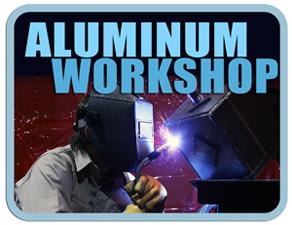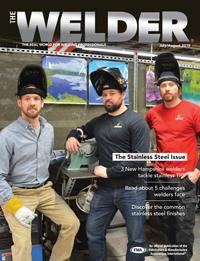President
- FMA
- The Fabricator
- FABTECH
- Canadian Metalworking
Categories
- Additive Manufacturing
- Aluminum Welding
- Arc Welding
- Assembly and Joining
- Automation and Robotics
- Bending and Forming
- Consumables
- Cutting and Weld Prep
- Electric Vehicles
- En Español
- Finishing
- Hydroforming
- Laser Cutting
- Laser Welding
- Machining
- Manufacturing Software
- Materials Handling
- Metals/Materials
- Oxyfuel Cutting
- Plasma Cutting
- Power Tools
- Punching and Other Holemaking
- Roll Forming
- Safety
- Sawing
- Shearing
- Shop Management
- Testing and Measuring
- Tube and Pipe Fabrication
- Tube and Pipe Production
- Waterjet Cutting
Industry Directory
Webcasts
Podcasts
FAB 40
Advertise
Subscribe
Account Login
Search
Aluminum Workshop: Macroetching and cleaning aluminum
- By Frank Armao
- Updated August 7, 2023
- July 18, 2019
- Article
- Aluminum Welding
Someone sent me an email recently asking how to macroetch samples of aluminum welds. I gave the standard—and correct—answer to use 10 percent hot (160 degrees F) ammonium hydroxide solution. However, the emailer replied that his shop rules prohibited him from using ammonium hydroxide and asked me if there were any alternatives. That made me think about common substances that can be used to macroetch samples and clean aluminum before welding takes place.
Macroetching
Let’s discuss macroetching first. You do not need to handle pure ammonium hydroxide, which is very corrosive. You should be able to buy a 10 percent solution, which is not dangerous to handle. If this still is not acceptable, you can choose among several alternatives.
Every industrial chemical company offers strong aluminum degreasers. If these are mixed according to the manufacturer’s recommendation and used hot (again, 150 to 160 degrees F), they will do a fine job macroetching aluminum samples. But there is an even simpler solution. Any of the spray oven cleaners that you can buy at the supermarket are also alkaline materials and will do a fine job macroetching aluminum weld samples, even if used right out of the can at room temperature. This is the easiest solution and probably is acceptable to use in almost any shop. You would be surprised at how effective this is.
Cleaning Aluminum Preweld
Let’s move on to preweld cleaning. Again, the standard and best recommendation is to wipe the area you are going to weld with a strong degreaser such as acetone or toluene before you weld. But use caution. If you do not allow these materials enough time to evaporate, they can evolve into poisonous phosgene gas when heated by an arc. Again, let these materials evaporate before you weld.
If you are not allowed to use these chemicals in your shop, you can choose between a couple of alternatives. Carburetor cleaner and liquid-penetrant cleaner make very effective preweld degreasers and should be allowed by your shop rules.
As a last resort, I have seen common cleaner/degreasers, such as Simple Green, used as effective preweld cleaners. I am a bit reluctant to recommend them because they do not evaporate and can leave a residue behind. If you do choose to use them, be sure to wipe them off completely before you weld.
About the Author

Frank Armao
Aluminum Consulting Inc.
440-479-0239
About the Publication
subscribe now

The Welder, formerly known as Practical Welding Today, is a showcase of the real people who make the products we use and work with every day. This magazine has served the welding community in North America well for more than 20 years.
start your free subscription- Stay connected from anywhere

Easily access valuable industry resources now with full access to the digital edition of The Fabricator.

Easily access valuable industry resources now with full access to the digital edition of The Welder.

Easily access valuable industry resources now with full access to the digital edition of The Tube and Pipe Journal.
- Podcasting
- Podcast:
- The Fabricator Podcast
- Published:
- 04/16/2024
- Running Time:
- 63:29
In this episode of The Fabricator Podcast, Caleb Chamberlain, co-founder and CEO of OSH Cut, discusses his company’s...
- Industry Events
16th Annual Safety Conference
- April 30 - May 1, 2024
- Elgin,
Pipe and Tube Conference
- May 21 - 22, 2024
- Omaha, NE
World-Class Roll Forming Workshop
- June 5 - 6, 2024
- Louisville, KY
Advanced Laser Application Workshop
- June 25 - 27, 2024
- Novi, MI
































